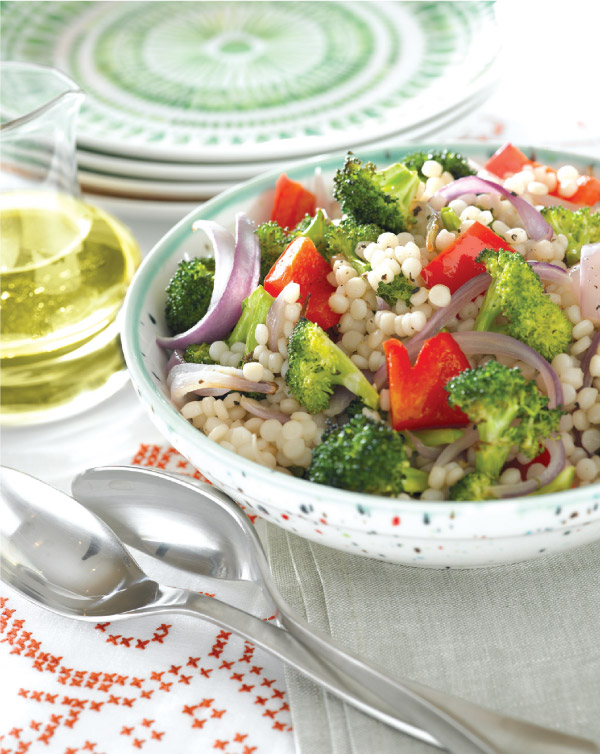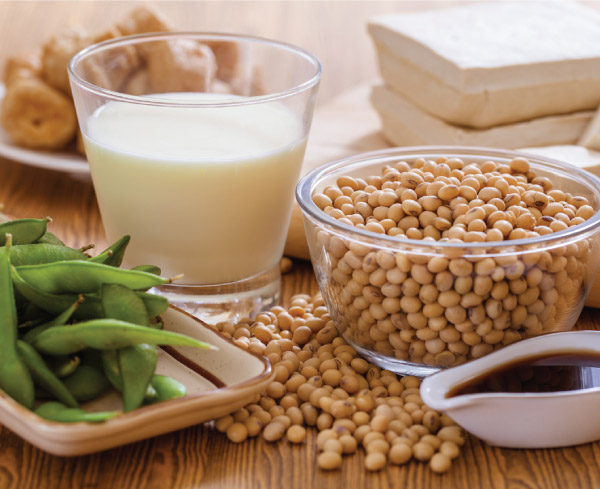SOY + HEART HEALTH
Soyfoods can make important contributions to heart-healthful diets, including high-quality protein and ample amounts of omega-6 and omega-3 essential fatty acids.
Introduction
Coronary artery disease and stroke, the two primary diseases comprising cardiovascular disease (CVD), account for over 20 percent of deaths worldwide, but there are striking variations in age-adjusted CVD mortality rates among countries.1 These international variations are not due to genetic differences among populations. This is evident from trends in rates within countries and changes in rates among migrants moving from low-risk to high-risk countries.
The United States has one of the highest rates of CVD in the world.2 In the most recent year (2015) for which data are available, an estimated 17.9 million Americans were affected by CVD.
The number of coronary deaths divides approximately evenly between men and women, although the average age of a first heart attack is approximately 64 for men and 70 for women.3 On the other hand, risk factors such as high blood pressure and diabetes increase heart attack risk in women more severely than in men.
According to the American Heart Association (AHA), in addition to age and gender, risk is primarily determined by total cholesterol level, high-density-lipoprotein cholesterol (HDL-C) level, systolic blood pressure, and whether one smokes and has diabetes.

Heart disease strikes someone in the U.S. every 40 seconds and kills over367,000 Americans each year.3

Approximately one in seven deaths in the U.S. is caused by coronary heart disease (CHD), making CHD the number one killer of Americans.3
720,000 Americans have a new coronary attack (defined as first hospitalized myocardial infarction or CHD death) each year.3
335,000 Americans have a recurrent coronary attack annually.3
160,000 Americans experience a silent first myocardial infarction each year.3
Evidence indicates that adjusted population attributable fractions for CVD mortality are as follows3:
| 40.6% | for high blood pressure |
| 13.7% | for smoking |
| 13.3% | for poor diet |
| 11.9% | for insufficient physical activity |
| 8.8% | for abnormal glucose levels |

From the information above, it is clear that dietary choices can significantly impact the risk of developing CVD. While markedly reducing CVD risk via dietary modification requires a comprehensive approach, there is little doubt that soyfoods can play an important role in heart-healthy diets.
Effects of Soy Protein on Circulating Lipid Levels
The first clinical trial demonstrating the cholesterol-lowering effect of soy protein was published in 1967.4 Throughout the 1970s and 1980s, Italian researchers were instrumental in showing that soy protein directly lowered blood cholesterol levels in very hypercholesterolemic patients.5-7 Nevertheless, it wasn’t until 1995 that the cholesterol-lowering effects of soy protein received widespread recognition. In that year, a meta-analysis of the clinical data, which included 38 different comparisons, found that soy protein reduced low-density-lipoprotein cholesterol (LDL-C) by approximately 13 percent.8
Four years after the meta-analysis, and after conducting its own analysis, the U.S. Food and Drug Administration (FDA) approved an “unqualified” health claim for soyfoods and CHD based on the cholesterol-lowering effects of soy protein.9 An “unqualified” claim indicates that there was significant scientific agreement in support of it. The FDA established 25 g/d soy protein as the threshold intake of cholesterol reduction.
Despite the fact that claims similar to the FDA claim have subsequently been approved in >10 other countries10 including most recently Canada, which did so in 2015,11 and that meta-analyses show soy protein statistically significantly lowers LDL-C approximately 4 to 6 percent,11-20 in October of 2017, the FDA announced its intention to revoke the existing “unqualified” claim citing inconsistency in the data.21 It is possible that soy protein will receive a “qualified” claim, but the FDA does not plan to make a final decision until September of 2019.
Some inconsistency in the literature is expected given that many trials involved relatively small sample sizes and that in general about 20 percent of individuals whose cholesterol levels are elevated do not respond to dietary changes.22Such data inconsistency exists even for many well-accepted approaches for lowering elevated cholesterol including those for which an FDA-approved unqualified health claim exists. For example, this is the case for oat–glucan23 and phytosterols/stanols.24 Nevertheless, meta-analyses of the clinical studies show oat-glucan23 and phytosterols/stanols24 statistically significantly lower LDL-C.
In the case of soy protein in its reevaluation of the data, the FDA found that of the 46 studies included in its analysis,19 41 percent reported a statistically significant decrease in total cholesterol and/or LDL-C. In the view of the FDA, this percentage was too low for the health claim to be maintained. However, this binary approach (studies were either supportive or unsupportive of the health claim based on statistical significance) to interpreting the data can be called into question. To this point, in 2015, Health Canada also recognized that only a minority of studies (33 percent) reported a statistically significant reduction in LDL-C in response to soy protein.11 Nevertheless, because Health Canada also found that 81 percent of the studies showed a reduction in LDL-C irrespective of whether the finding was statistically significant, the data were considered sufficiently consistent for a health claim to be allowed.
The FDA did not meta-analyze the data from the 46 studies included in its analysis. These data were meta-analyzed by Jenkins and colleagues with the results showing a statistically significant 3.2 percent reduction in LDL-C (approximately 75 percent of the studies showed a reduction). Although the magnitude of reduction is lower than past estimates, each 1 percent decrease in LDL-C is estimated to lower CHD risk by 1 to 3 percent, thus, in theory, incorporating soy protein into the diet can substantially reduce CHD morbidity and mortality.25,26
Finally, research shows that soy protein modestly raises HDL-C and lowers circulating triglyceride levels.14 In addition, soy protein was found to decrease postprandial triglyceride levels, elevated levels of which are increasingly viewed as important for reducing CHD risk.27

| SOYFOOD | SERVING SIZE | GRAMS OF SOY PROTEIN |
|---|---|---|
| Fortified Soymilk | 1 cup | 6-7 |
| Soy Cereal | 1 ¼ cup | 7 |
| Soy Yogurt, Vanilla | 1 cup | 6 |
| Soy Breakfast Patty | 2 patties | 11 |
| Soy Bar | 1 bar | 14 |
| Soy Chips | 1 bag | 7 |
| Soynut Butter | 2 tbsp | 7 |
| Soynuts, Roasted, Unsalted | ¼ cup | 11 |
| Tofu | ½ cup | 10 |
| Edamame | ½ cup | 11 |
| Soy Burger | 1 patty | 13-14 |
| Soy Pasta | ½ cup (cooked) | 13 |
| Soy Pudding | ½ cup | 6 |
Source: United States Department of Agriculture Nutrient Database.
Effects of Soy Fat on CHD Risk
In contrast to other legumes which are nearly fat-free, approximately 40% of the calories from soybeans are comprised of fat.28 The fatty acid composition of soybean oil is very heart-healthy as it is comprised of approximately 12% saturated fat, 29% monounsaturated fat and 59% polyunsaturated fat (PUFA, ~53% linoleic acid and ~6% α-linolenic acid).29 Not surprisingly, given its composition, soybean oil has been shown to lower LDL-C.30 In fact, the hypocholesterolemic effect has been demonstrated so convincingly that the FDA recently approved a very strong qualified health claim for soybean oil and CHD.31 Although saturated fat is typically discussed more in relation to CHD risk, a recent analysis found that in many countries around the world, inadequate intake of PUFA contributes much more to CHD mortality than an excess intake of saturated fat.32
The essential omega-3 fatty acid α-linolenic acid (ALA) does not possess the same properties as the long-chain omega-3 fatty acids found in cold-water fish; nevertheless, evidence suggests that ALA has direct coronary benefits, although there is disagreement on this point.33-36 Notable in this regard is the recent conclusion by the AHA that ALA may reduce risk of fatal CHD.37 Other evidence supports this conclusion as well.38 In recent years, controversy has risen about the impact of saturated fat on CHD risk with some analyses finding no relationship.39 Certainly, it is recognized that not all dietary saturated fatty acids exert the same effect on serum LDL-C.40 Also, the impact of dietary saturated fatty acids on serum LDL-C may depend upon the type and composition of food in which the saturated fat is consumed. For example, saturated fat in butter raises LDL-C to a much greater extent than saturated fat in cheese.41,42 This difference has been attributed to the high calcium content of cheese, which can form insoluble salts with the saturated fatty acids preventing them from being absorbed.43
More importantly, the failure of some observational studies to show saturated fat intake is associated with an increased risk of CVD isn’t because saturated fat doesn’t raise risk, but rather, because the impact of saturated fat is dependent upon the macronutrient that replaces it.37 To this point, a combined analysis of the Nurses’ Health Study (1980 to 2010, n=84,628) and the Health Professionals Follow-up Study (1986 to 2010, n= 42,908 men) found that replacing 5% of energy intake from saturated fat with equivalent energy intake from PUFA, monounsaturated fat, or carbohydrates from whole grains was associated with a 25%, 15%, and 9% lower risk of CHD, respectively. Whereas replacing saturated fat with carbohydrates from refined starches/added sugars was not significantly associated with CHD risk.44 Similar findings exist for total mortality and for CHD-specific mortality.45
Blood Pressure
Four meta-analyses have concluded that soy modestly lowers blood pressure.18,46-48 In the largest of these, which included 27 studies, soy lowered systolic and diastolic blood pressure by 2.21 and 1.44 mgHg, respectively.46 Reducing systolic blood pressure by just 2-5 mmHg may reduce stroke and CHD disease by 6 to 14 percent and 5 to 9 percent, respectively.49 Despite the intriguing data, no conclusions about the hypotensive effects of soy protein can be made because in most of the trials included in the meta-analyses, blood pressure was not the primary outcome of interest.

Inflammation
Despite its cholesterol-lowering effect, some concerns have been raised that too much omega-6 PUFA and in particular, linoleic acid, may increase CHD risk by increasing inflammation. However, the AHA has rejected concerns about the pro-inflammatory properties of linoleic acid and concluded that omega-6 PUFA play a critically important role in heart-healthful diets.50 This position is supported by a comprehensive review by Johnson and Fritsche51 that concluded that “virtually no evidence is available from randomized, controlled intervention studies among healthy, non-infant human beings to show that addition of LA to the diet increases the concentration of inflammatory markers.”52 More recently, in the Kuopio Ischaemic Heart Disease Risk Factor Study, Virtanen et al.52 found that serum linoleic acid levels were strongly inversely related to serum C-reactive protein, which is a general marker of inflammation. This study involved 1,287 generally healthy men aged 42 to 60 years.
There are several reasons why omega-6 PUFA are not proinflammatory as commonly thought. One is that although linoleic acid is converted to arachidonic acid (AA), from which a number of pro-inflammatory eicosanoids are produced, tissue levels of AA don’t substantially increase in response to linoleic intake because they are tightly regulated.53 Also, it is now recognized that not all of the eicosanoids produced from AA are pro-inflammatory; some in fact may be anti-inflammatory.54

Endothelial Function (Vasodilation)
Two meta-analyses have found that soybean isoflavones improved endothelial function in postmenopausal women.55,56 Endothelial cells line the blood vessels and their functioning can impact CHD risk. When the data from one of these meta-analyses were sub-analyzed, the improvement was found only in those women who had impaired endothelial function at baseline.55 The fat in soyfoods may also favorably affect endothelial function. British researchers recently found that, when compared to saturated fat, unsaturated fat increased the number of endothelial progenitor cells, which are cells that play a role in regenerating the lining of the endothelium. In this cross-over trial, men and women consumed three diets containing different amounts of saturated and unsaturated fat for 16-week periods.57
Unlike endothelial-mediated vasodilation (primarily nitric oxide-dependent), arterial compliance relates to the constriction and dilation of arteries associated with systole and diastole. Arterial compliance is determined by components of the artery wall, such as elastin, proteoglycans and smooth muscle cell function. The most straightforward, valid and reliable measure of arterial stiffness is pulse wave velocity, which is predictive of future cardiovascular events.58

In 2011, a systematic review by Pase et al.59 concluded on the basis of five studies60-64 that isoflavones reduce arterial stiffness although one of the four that reported benefit intervened with an isoflavone metabolite.64 Three additional studies not reviewed by Pase et al.59 are supportive of the ability of isoflavones to improve arterial compliance in postmenopausal women.65-67 Conversely, no differences in arterial compliance were noted in a small group of hypercholesterolemic men and women when comparing a soymilk/soy yogurt intervention to a dairy milk/yogurt intervention.68
Efflux Capacity
Efflux capacity, which refers to the ability to remove cholesterol from lipid-laden macrophages, is inversely related to CHD risk.69 Recent data show that in comparison to saturated fat, unsaturated fat can enhance cholesterol efflux capacity.70 This effect on efflux capacity may represent another mechanism by which unsaturated fat reduces CHD risk.
Summary and Conclusions
Soyfoods can make important contributions to heart-healthful diets through several different mechanisms. They provide high-quality protein but minimal amounts of saturated fat. They provide ample amounts of omega-6 and omega-3 essential fatty acids. Soy protein directly lowers blood LDL-C levels, modestly elevates HDL-C and decreases triglyceride levels. Furthermore, soyfoods may favorably affect CHD risk factors independent of lipid levels — for example, by improving endothelial function and systematic arterial compliance and lowering blood pressure. Given all of these attributes, it is not surprising that soyfoods and soy protein are important components of the portfolio diet, a diet which has been shown to markedly lower LDL-C and blood pressure.71
References
1. Mathers CD, Loncar D. Projections of global mortality and burden of disease from 2002 to 2030. PLoS Med. 2006;3(11):e442.
2. MacMahon S, Peto R, Cutler J, et al. Blood pressure, stroke, and coronary heart disease. Part 1, Prolonged differences in blood pressure: prospective observational studies corrected for the regression dilution bias. Lancet. 1990;335(8692):765-74.
3. Benjamin EJ, Virani SS, Callaway CW, et al. Heart disease and stroke statistics-2018 update: A report from the American Heart Association. Circulation. 2018;137(12):e67-e492.
4. Hodges RE, Krehl WA, Stone DB, et al. Dietary carbohydrates and low cholesterol diets: effects on serum lipids on man. Am J Clin Nutr. 1967;20(2):198-208.
5. Sirtori CR, Agradi E, Conti F, et al. Soybean-protein diet in the treatment of type-II hyperlipoproteinaemia. Lancet.1977;1(8006):275-7.
6. Sirtori CR, Gatti E, Mantero O, et al. Clinical experience with the soybean protein diet in the treatment of hypercholesterolemia. Am J Clin Nutr. 1979;32(8):1645-58.
7. Sirtori CR, Zucchi-Dentone C, Sirtori M, et al. Cholesterol-lowering and HDL-raising properties of lecithinated soy proteins in type II hyperlipidemic patients. Ann Nutr Metab. 1985;29(6):348-57.
8. Anderson JW, Johnstone BM, Cook-Newell ME. Meta-analysis of the effects of soy protein intake on serum lipids. N Engl J Med. 1995;333(5):276-82.
9. Food Labeling: Health Claims; Soy Protein and Coronary Heart Disease. In: Federal Register: (Volume 64, Number 206)];1999:57699-733.
10. Xiao CW. Health effects of soy protein and isoflavones in humans. J Nutr. 2008;138(6):1244S-9S.
11. Benkhedda K, Boudrault C, Sinclair SE, et al. Food Risk Analysis Communication. Issued By Health Canada’s Food Directorate. Health Canada’s Proposal to Accept a Health Claim about Soy Products and Cholesterol Lowering. Int Food Risk Anal J. 2014;4:22 | doi: 10.5772/59411.
12. Zhan S, Ho SC. Meta-analysis of the effects of soy protein containing isoflavones on the lipid profile. Am J Clin Nutr. 2005;81(2):397-408.
13. Harland JI, Haffner TA. Systematic review, meta-analysis and regression of randomised controlled trials reporting an association between an intake of circa 25 g soya protein per day and blood cholesterol. Atherosclerosis. 2008;200(1):13-27.
14. Anderson JW, Bush HM. Soy protein effects on serum lipoproteins: A quality assessment and meta-analysis of randomized, controlled studies. J Am Coll Nutr. 2011;30(2):79-91.
15. Tokede OA, Onabanjo TA, Yansane A, et al. Soya products and serum lipids: a meta-analysis of randomised controlled trials. Br J Nutr. 2015;114(6):831-43.
16. Yang B, Chen Y, Xu T, et al. Systematic review and meta-analysis of soy products consumption in patients with type 2 diabetes mellitus. Asia Pacific journal of clinical nutrition. 2011;20(4):593-602.
17. Jenkins DJ, Mirrahimi A, Srichaikul K, et al. Soy protein reduces serum cholesterol by both intrinsic and food displacement mechanisms. J Nutr. 2010;140(12):2302S-11S.
18. Hooper L, Kroon PA, Rimm EB, et al. Flavonoids, flavonoid-rich foods, and cardiovascular risk: a meta-analysis of randomized controlled trials. Am J Clin Nutr. 2008;88(1):38-50.
19. Reynolds K, Chin A, Lees KA, et al. A meta-analysis of the effect of soy protein supplementation on serum lipids. Am J Cardiol. 2006;98(5):633-40.
20. Weggemans RM, Trautwein EA. Relation between soy-associated isoflavones and LDL and HDL cholesterol concentrations in humans: a meta-analysis. Eur J Clin Nutr. 2003;57(8):940-6.
21. US Food and Drug Administration. Food labeling: health claims; Soy protein and coronary heart disease. Fed Reg. 2017;8250324-46.
22. Denke MA, Adams-Huet B, Nguyen AT. Individual cholesterol variation in response to a margarine- or butter- based diet: A study in families. JAMA. 2000;284(21):2740-7.
23. Ho HV, Sievenpiper JL, Zurbau A, et al. The effect of oat beta-glucan on LDL-cholesterol, non-HDL-cholesterol and apoB for CVD risk reduction: a systematic review and meta-analysis of randomised-controlled trials. Br J Nutr. 2016;116(8):1369-82.
24. Amir Shaghaghi M, Abumweis SS, Jones PJ. Cholesterol-lowering efficacy of plant sterols/stanols provided in capsule and tablet formats: results of a systematic review and meta-analysis. Journal of the Academy of Nutrition and Dietetics. 2013;113(11):1494-503.
25. Law MR, Wald NJ, Thompson SG. By how much and how quickly does reduction in serum cholesterol concentration lower risk of ischaemic heart disease? BMJ. 1994;308(6925):367-72.
26. Law MR, Wald NJ, Wu T, et al. Systematic underestimation of association between serum cholesterol concentration and ischaemic heart disease in observational studies: data from the BUPA study. BMJ. 1994;308(6925):363-6.
27. Santo AS, Santo AM, Browne RW, et al. Postprandial lipemia detects the effect of soy protein on cardiovascular disease risk compared with the fasting lipid profile. Lipids. 2010;45(12):1127-38.
28. Messina MJ. Legumes and soybeans: overview of their nutritional profiles and health effects. Am J Clin Nutr. 1999;70(3 Suppl):439S-50S.
29. Hayes KC. Dietary fatty acids, cholesterol, and the lipoprotein profile. Br J Nutr. 2000;84(4):397-9.
30. Kris-Etherton PM, Derr J, Mitchell DC, et al. The role of fatty acid saturation on plasma lipids, lipoproteins, and apolipoproteins: I. Effects of whole food diets high in cocoa butter, olive oil, soybean oil, dairy butter, and milk chocolate on the plasma lipids of young men. Metabolism. 1993;42(1):121-9.
31. Qualified Health Claim Petition - Docket No FDA-2016-Q-0995 (https://google2.fda.gov/search?q=soybean+oil+health+claim&client=FDAgov&site=FDAgov&lr=&proxystylesheet=FDAgov&requiredfields=-archive%3AYes&output=xml_no_dtd&getfields=*).
32. Wang Q, Afshin A, Yakoob MY, et al. Impact of nonoptimal intakes of saturated, polyunsaturated, and trans fat on global burdens of coronary heart disease. Journal of the American Heart Association. 2016;5(1).
33. Brouwer IA, Katan MB, Zock PL. Dietary alpha-linolenic acid is associated with reduced risk of fatal coronary heart disease, but increased prostate cancer risk: a meta-analysis. J Nutr. 2004;134(4):919-22.
34. Holguin F, Tellez-Rojo MM, Lazo M, et al. Cardiac autonomic changes associated with fish oil vs soy oil supplementation in the elderly. Chest. 2005;127(4):1102-7.
35. Whelan J. Dietary stearidonic acid is a long chain (n-3) polyunsaturated fatty acid with potential health benefits. J Nutr. 2009;139(1):5-10.
36. Wei J, Hou R, Xi Y, et al. The association and dose-response relationship between dietary intake of alpha-linolenic acid and risk of CHD: a systematic review and meta-analysis of cohort studies. Br J Nutr. 2018;119(1):83-9.
37. Sacks FM, Lichtenstein AH, Wu JHY, et al. Dietary fats and cardiovascular disease: A presidential advisory from the American Heart Association. Circulation. 2017;136(3):e1-e23.
38. Abdelhamid AS, Brown TJ, Brainard JS, et al. Omega-3 fatty acids for the primary and secondary prevention of cardiovascular disease. The Cochrane database of systematic reviews. 2018;7CD003177.
39. Chowdhury R, Warnakula S, Kunutsor S, et al. Association of dietary, circulating, and supplement fatty acids with coronary risk: a systematic review and meta-analysis. Ann Intern Med. 2014;160(6):398-406.
40. Kris-Etherton PM, Yu S. Individual fatty acid effects on plasma lipids and lipoproteins: human studies. Am J Clin Nutr. 1997;65(5 Suppl):1628S-44S.
41. Hjerpsted J, Leedo E, Tholstrup T. Cheese intake in large amounts lowers LDL-cholesterol concentrations compared with butter intake of equal fat content. Am J Clin Nutr. 2011;94(6):1479-84.
42. de Goede J, Geleijnse JM, Ding EL, et al. Effect of cheese consumption on blood lipids: a systematic review and meta-analysis of randomized controlled trials. Nutr Rev. 2015;73(5):259-75.
43. Soerensen KV, Thorning TK, Astrup A, et al. Effect of dairy calcium from cheese and milk on fecal fat excretion, blood lipids, and appetite in young men. Am J Clin Nutr. 2014;99(5):984-91.
44. Li Y, Hruby A, Bernstein AM, et al. Saturated fats compared with unsaturated fats and sources of carbohydrates in relation to risk of coronary heart disease: A prospective cohort study. J Am Coll Cardiol. 2015;66(14):1538-48.
45. Wang DD, Li Y, Chiuve SE, et al. Association of specific dietary fats with total and cause-specific mortality. JAMA internal medicine. 2016;176(8):1134-45.
46. Dong JY, Tong X, Wu ZW, et al. Effect of soya protein on blood pressure: a meta-analysis of randomised controlled trials. Br J Nutr. 2011;106(3):317-26.
47. Taku K, Lin N, Cai D, et al. Effects of soy isoflavone extract supplements on blood pressure in adult humans: systematic review and meta-analysis of randomized placebo-controlled trials. J Hypertens. 2010;28(10):1971-82.
48. Liu XX, Li SH, Chen JZ, et al. Effect of soy isoflavones on blood pressure: A meta-analysis of randomized controlled trials. Nutrition, metabolism, and cardiovascular diseases : NMCD. 2012;22(6):463-70.
49. Stamler R. Implications of the INTERSALT study. Hypertension. 1991;17(1 Suppl):I16-20.
50. Harris WS, Mozaffarian D, Rimm E, et al. Omega-6 fatty acids and risk for cardiovascular disease: a science advisory from the American Heart Association Nutrition Subcommittee of the Council on Nutrition, Physical Activity, and Metabolism; Council on Cardiovascular Nursing; and Council on Epidemiology and Prevention. Circulation. 2009;119(6):902-7.
51. Johnson GH, Fritsche K. Effect of dietary linoleic acid on markers of inflammation in healthy persons: A systematic review of randomized controlled trials Journal of the Academy of Nutrition and Dietetics. 2012;1121029-41.
52. Virtanen JK, Mursu J, Voutilainen S, et al. The associations of serum n-6 polyunsaturated fatty acids with serum C-reactive protein in men: the Kuopio Ischaemic Heart Disease Risk Factor Study. Eur J Clin Nutr. 2018;72(3):342-8.
53. Rett BS, Whelan J. Increasing dietary linoleic acid does not increase tissue arachidonic acid content in adults consuming Western-type diets: a systematic review. Nutr Metab (Lond). 2011;836.
54. Harris WS, Shearer GC. Omega-6 fatty acids and cardiovascular disease: friend, not foe? Circulation. 2014;130(18):1562-4.
55. Li SH, Liu XX, Bai YY, et al. Effect of oral isoflavone supplementation on vascular endothelial function in postmenopausal women: a meta-analysis of randomized placebo-controlled trials. Am J Clin Nutr. 2010;91(2):480-6.
56. Beavers DP, Beavers KM, Miller M, et al. Exposure to isoflavone-containing soy products and endothelial function: A Bayesian meta-analysis of randomized controlled trials. Nutrition, metabolism, and cardiovascular diseases : NMCD. 2012;22(3):182-91.
57. Weech M, Altowaijri H, Mayneris-Perxachs J, et al. Replacement of dietary saturated fat with unsaturated fats increases numbers of circulating endothelial progenitor cells and decreases numbers of microparticles: findings from the randomized, controlled Dietary Intervention and VAScular function (DIVAS) study. Am J Clin Nutr. 2018.
58. Vlachopoulos C, Aznaouridis K, Stefanadis C. Prediction of cardiovascular events and all-cause mortality with arterial stiffness: a systematic review and meta-analysis. J Am Coll Cardiol. 2010;55(13):1318-27.
59. Pase MP, Grima NA, Sarris J. The effects of dietary and nutrient interventions on arterial stiffness: a systematic review. Am J Clin Nutr. 2011;93(2):446-54.
60. Teede HJ, Dalais FS, Kotsopoulos D, et al. Dietary soy has both beneficial and potentially adverse cardiovascular effects: a placebo-controlled study in men and postmenopausal women. J Clin Endocrinol Metab. 2001;86(7):3053-60.
61. Teede HJ, McGrath BP, DeSilva L, et al. Isoflavones reduce arterial stiffness: a placebo-controlled study in men and postmenopausal women. Arterioscler Thromb Vasc Biol. 2003;23(6):1066-71.
62. Tormala R, Appt S, Clarkson TB, et al. Equol production capability is associated with favorable vascular function in postmenopausal women using tibolone; no effect with soy supplementation. Atherosclerosis. 2008;198(1):174-8.
63. Nestel PJ, Yamashita T, Sasahara T, et al. Soy isoflavones improve systemic arterial compliance but not plasma lipids in menopausal and perimenopausal women. Arterioscler Thromb Vasc Biol. 1997;17(12):3392-8.
64. Nestel P, Fujii A, Zhang L. An isoflavone metabolite reduces arterial stiffness and blood pressure in overweight men and postmenopausal women. Atherosclerosis. 2007;192(1):184-9.
65. Nestel PJ, Pomeroy S, Kay S, et al. Isoflavones from red clover improve systemic arterial compliance but not plasma lipids in menopausal women. J Clin Endocrinol Metab. 1999;84(3):895-8.
66. Curtis PJ, Potter J, Kroon PA, et al. Vascular function and atherosclerosis progression after 1 y of flavonoid intake in statin-treated postmenopausal women with type 2 diabetes: a double-blind randomized controlled trial. Am J Clin Nutr. 2013;97(5):936-42.
67. Reverri EJ, LaSalle CD, Franke AA, et al. Soy provides modest benefits on endothelial function without affecting inflammatory biomarkers in adults at cardiometabolic risk. Mol Nutr Food Res. 2015;59(2):323-33.
68. Meyer BJ, Larkin TA, Owen AJ, et al. Limited lipid-lowering effects of regular consumption of whole soybean foods. Ann Nutr Metab. 2004;48(2):67-78.
69. Rosenson RS, Brewer HB, Jr., Davidson WS, et al. Cholesterol efflux and atheroprotection: advancing the concept of reverse cholesterol transport. Circulation. 2012;125(15):1905-19.
70. Liu X, Garban J, Jones PJ, et al. Diets low in saturated fat with different unsaturated fatty acid profiles similarly increase serum-mediated cholesterol efflux from thp-1 macrophages in a population with or at risk for metabolic syndrome: the canola oil multicenter intervention trial J Nutr. 2018;148721-8.
71. Chiavaroli L, Nishi SK, Khan TA, et al. Portfolio dietary pattern and cardiovascular disease: A systematic review and meta-analysis of controlled trials. Prog Cardiovasc Dis. 2018.
Connect with us through our social channels